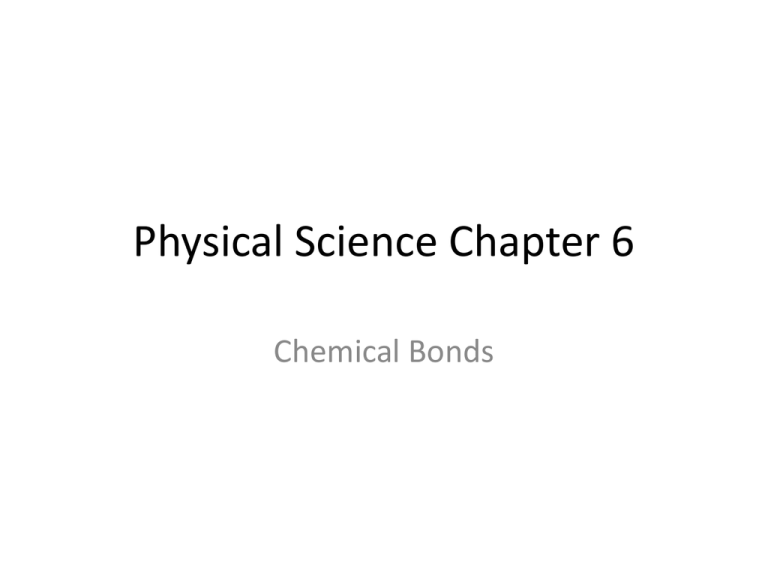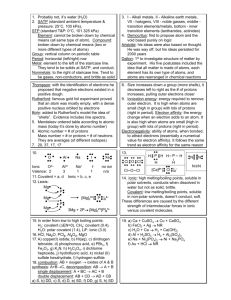Physical Science Chapter 6
advertisement

Physical Science Chapter 6 Chemical Bonds Bonding • Chapter 6 is about different types of atomic bonding • Forces of attraction is the key to this bonding • The physical properties of elements is key to the different types of bonds Bonding • Draw the electron configuration of the elements neon and sodium • What do you notice about the Valence electrons and the energy level of each element? Stable Electron Configurations • When the highest occupied energy level of an atom is filled with electrons, the atom is stable and not likely to react Ionic Bonds • Elements without complete sets of valence electrons tend to react • They react to try to achieve the stability of a full energy level…like the noble gases Transfer of Electrons • Look at the electron dot diagrams for sodium and chlorine • What do you think these elements will want to do? Atomic Chemical Reaction When sodium and chlorine react: An electron is transferred from each sodium atom to a chlorine atom. Now each atom is more stable When an atom gains or loses an electron, the protons and electrons are no longer equal and the atom is not neutral. An atom with a positive or negative charge is an ion • Notice the positive and negative charge on the new sodium and chlorine atoms Charge • An ion with a negative charge is an anion. • Chlorine in NaCl is an anion…Cl• It is negative because it has one more electron than protons, thus a charge of 1• Anions are written using a part of the elemental name and the suffix ide. –chloride • Our new sodium ion, because it lost an electron now has more protons than electrons, making it positive or 1+ + –Na • Cations are named just using the elemental name, sodium Chemical Bonds • A chemical bond is what holds atoms or ions together • Ionic bonds are what holds cations and anions together –Ionic bond forms when electrons are transferred from one atom to another Chemical Bonds • http://www.youtube.com/watch?v=QXT4OVM 4vXI Ionization Energy • The amount of energy used to remove an electron from an atom is ionization energy • It varies form element to element • The lower the ionization energy, the easier it is to remove an electron • Which element would it be easier to take an electron from, Magnesium or Calcium? Ionic Compounds • Compounds that contain ionic bonds are ionic compounds • These can be represented by a chemical formula: –Notation that shows what elements a compound contains and the ratio of the atoms or ions of these elements in the compound: NaCl Practice • We want to make a compound with magnesium and chloride • What group is magnesium in? • What group is chlorine in? How will we combine these elements? + = How will we combine these elements? + = MgCl2 • MgCl2 = The subscript 2 shows how many atoms of that element are present • If there is not a subscript, that implies that there is only one atom Ratios are Easier • It is easier to see the number of atoms when you break a formula down into ratios • For example, H2O has a hydrogen to oxygen ratio of 2:1 • Find the ratios of the following formulas: • Sodium Chloride, NaCl= • Magnesium Chloride, MgCl2= • Sodium Oxide, Na2O= Crystal Lattices • How are the ions in a grain of salt arranged?(162) • Attractions between opposing charges keeps the ions in a fixed, repeating position • Solids whose particles are arranged in lattice structure are called crystals • The shape of an ionic crystal depends on the arrangement of ions in its lattice • The arrangement of the ions depends on the ratio of ions (like the exercise you just did) and their relative sizes Compare • • • • • Compare figure 5a and 5b (pg 162) Answer the following questions: 1. How are the sodium ions represented? 2. How are the Chloride ions represented? 3. What do you notice about the locations of the positive and negative ions? • 4. What is the similarity between the diagram of NaCl and the photograph of NaCl? Properties of Ionic Compounds • The properties of NaCl are typical of other ionic compounds: • High melting point (801 degrees Celsius) • As a solid they are poor electric conductors • As a liquid they are good electric conductors • They shatter when struck with a hammer • All of these properties of ionic compounds are explained by the strong attractions within a crystal lattice • For electric current to flow, charged particles must be able to flow from one location to another • Ions in a crystal lattice have a fixed position • When they melt, the lattice breaks apart and ions are free to flow • Melted sodium chloride is an excellent elctric conductor • Complete the section 1 assessment in your book and the questions in your workbook for this section Covalent bonds • http://www.youtube.com/watch?v=yjge1WdC FPs Covalent Bonds • Someone read Covalent Bonds, pg 165 • Covalent Bond: a chemical bond in which two atoms share a pair of valence electrons • Example: Hydrogen has one valence electron • If it had one more it could reach the stability of a full orbital for its energy level • So it wants to share an electron with another atom that also only has one valence electron… • Hydrogen • These two hydrogen atoms that share a valence electron form a molecule • Molecule: a neutral group of atoms that are joined together by one or more covalent bonds • The molecule is neutral because it has two protons and two electrons • The attraction between the shared electrons and the protons in the individual nuclei holds the atoms together in a covalent • The chemical formula for this covalent bond/molecule is H2 • The subscript 2 is for the 2 hydrogen atoms in the molecule • Diatomic molecules: Two atoms • Many nonmetals make diatomic molecules…why? • Halogens, for example, all have 7 valence electrons • If two of them share an electron they both achieve a stable electron configuration Multiple covalent bonds • Atoms can share more than one electron • They can share pairs • If they share 2 pairs, it is called a double bond • If they share 3 pairs it is called a triple pair Ionic and Covalent bonds • http://www.youtube.com/watch?v=QqjcCvzW www Polar Covalent Bonds • A covalent bond in which electrons are not shared equally is a polar covalent bond • Some atoms may have a greater attraction than others and thus the electrons spend more time near that atom in the bond than the other • Because they are sharing electrons, neither atom becomes + or – like ionic bonds. • However, they can become partially + or – when the electrons are shared unequally • If so, they are assigned the symbol delta – or delta +, depending on which one gains or loses the electrons most Polar and Nonpolar Molecules






